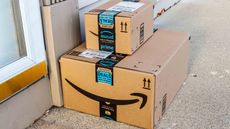What You Need to Know About Online Shopping Traps
The bad guys are getting smarter, but shoppers can stay a step ahead.

1. Select your own seller. If you're looking for a particular item, don't let a search engine pick a site for you -- go to a price-comparison site, such as PriceGrabber.com or Dealio.com. That's because hackers seed search results with fraudulent sites that phish for your personal information, says Michael Gregg, a cybersecurity consultant. Even if you're using a site that you think is legitimate, look for a security label, such as VeriSign or Cybertrust, and for https:// in the URL on pages that prompt you to enter personal information.
2. Shop at home. Never make purchases online using a public Wi-Fi connection. Hackers can tap into Wi-Fi connections at hot spots, such as coffee shops, airports and hotels, to capture your personal information. Also, never use a public computer to shop or check accounts online.
3. Pay with plastic. And make sure you use a credit card. If a hacker steals your debit card information and uses it to make unauthorized purchases, you must report any misuse within two days of learning of the fraud to get the same $50 limited liability you would get with a credit card. Miss that deadline but report your loss within 60 days and your liability is limited to $500. After 60 days, your liability is unlimited. That said, if you've been a good customer, most banks will credit your account within a couple of days after you report the fraud.

Sign up for Kiplinger’s Free E-Newsletters
Profit and prosper with the best of expert advice on investing, taxes, retirement, personal finance and more - straight to your e-mail.
Profit and prosper with the best of expert advice - straight to your e-mail.
4. Transfer with care. Wiring money by Western Union to pay for a purchase is also a bad idea. You're inviting fraud because you have no way to get your money back if the item you buy never arrives. And if you are making a large purchase, such as a car, and the seller tries to steer you to a particular escrow company to handle the transaction, be suspicious. Make sure the provider is legitimate by checking with state regulators, or ask to use an escrow company of your own choosing, such as Escrow.com.
5. Read your card bill. If you do a lot of shopping online, review your credit card accounts regularly to make sure there aren't any unauthorized purchases. Jon-Louis Heimerl, director of strategic security for Solutionary, a security-services company, recommends that you print out your receipts or put e-mail receipts into a separate folder so that you can check your statements against your receipts. He uses only one of his credit cards for online purchases, so he was able to catch an unauthorized purchase quickly when another of his credit cards was used to buy something on the Web.
6. Beware of bogus bargains. If a Web site or individual offers a deal that's off-the-charts cheap, demands a direct transfer of funds and won't accept credit cards, it's probably a scam. Social-networking sites, such as Twitter, can be a smart way to stay on top of deals. But note that the URLs on Twitter (and sometimes Facebook) are often shortened, so you won't know whether you're landing on a legitimate retailer's site by clicking the link. One option is to use a deal notification you see on Twitter as a tip, then research the details on your own. Also be wary of unsolicited e-mails promoting sales or deals -- even if the e-mail looks as if it came from a legitimate retailer. You're safer going directly to the retailer's site to see whether it's having a sale.
SEE OUR SLIDE SHOW for more online shopping traps to avoid.

To continue reading this article
please register for free
This is different from signing in to your print subscription
Why am I seeing this? Find out more here

Award-winning journalist, speaker, family finance expert, and author of Mom and Dad, We Need to Talk.
Cameron Huddleston wrote the daily "Kip Tips" column for Kiplinger.com. She joined Kiplinger in 2001 after graduating from American University with an MA in economic journalism.
-
 Stock Market Today: Stocks Run Out of Steam Ahead of Meta Earnings
Stock Market Today: Stocks Run Out of Steam Ahead of Meta EarningsThe Dow Jones Industrial Average snapped a four-day winning streak after Boeing's first-quarter results.
By Karee Venema Published
-
 One-Third of Parents Are Paying An Adult Child's House Down Payment? Are You?
One-Third of Parents Are Paying An Adult Child's House Down Payment? Are You?As housing costs soar, Gen Z and Millennial home buyers are turning to family for help with down payments.
By Kathryn Pomroy Published
-
 403(b) Contribution Limits for 2024
403(b) Contribution Limits for 2024retirement plans Teachers and nonprofit workers can contribute more to a 403(b) retirement plan in 2024 than they could in 2023.
By Jackie Stewart Published
-
 Roth IRA Contribution Limits for 2024
Roth IRA Contribution Limits for 2024Roth IRAs Roth IRA contribution limits have gone up for 2024. Here's what you need to know.
By Jackie Stewart Published
-
 Four Tips for Renting Out Your Home on Airbnb
Four Tips for Renting Out Your Home on Airbnbreal estate Here's what you should know before listing your home on Airbnb.
By Miriam Cross Published
-
 Five Ways to a Cheap Last-Minute Vacation
Five Ways to a Cheap Last-Minute VacationTravel It is possible to pull off a cheap last-minute vacation. Here are some tips to make it happen.
By Vaishali Varu Last updated
-
 How Much Life Insurance Do You Need?
How Much Life Insurance Do You Need?insurance Instead of relying on rules of thumb, you’re better off taking a systematic approach to figuring your life-insurance needs.
By Kimberly Lankford Published
-
 Five Reasons You Shouldn't Shop on Amazon Prime Day
Five Reasons You Shouldn't Shop on Amazon Prime DaySmart Buying Think twice before getting lured into buying a bunch of stuff you don't need just because it's on sale.
By Andrea Browne Taylor Published
-
 When Is Amazon Prime Day?
When Is Amazon Prime Day?Amazon Prime In 2023 Amazon had two Prime Day events — one in July and another, called Big Deal Days, in October. We expect 2024 to follow the same schedule.
By Bob Niedt Last updated
-
 How to Shop for Life Insurance in 3 Easy Steps
How to Shop for Life Insurance in 3 Easy Stepsinsurance Shopping for life insurance? You may be able to estimate how much you need online, but that's just the start of your search.
By Kaitlin Pitsker Published